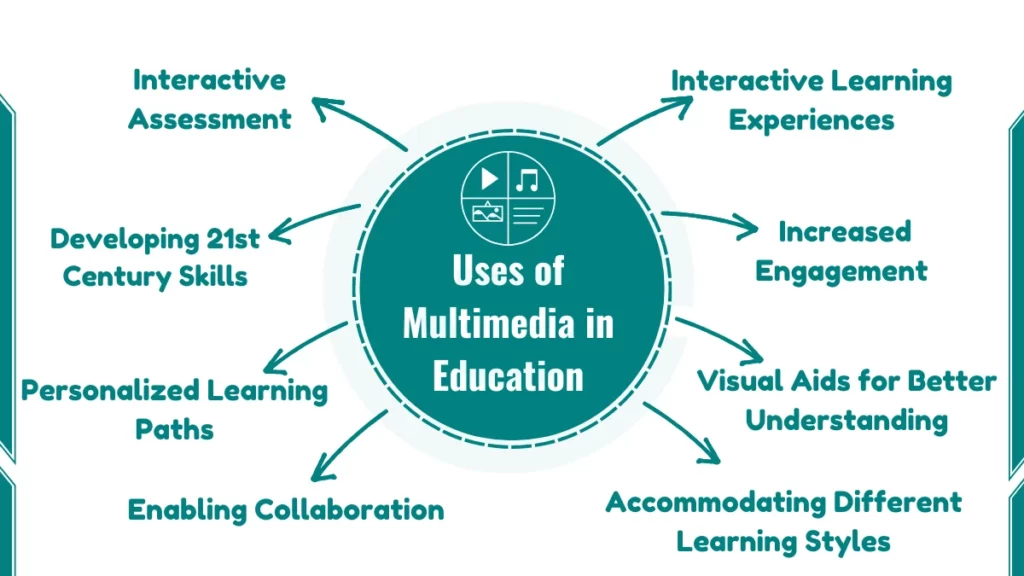Multimedia learning has emerged as a powerful tool in educational technology. Educational institutes use multimedia elements like text, images, audio, and video for engaging and interactive experiences. Educational institutions use multimedia resources like simulations, games, and videos to increase student engagement.
They are developed according to different learning styles. These interactive learning activities foster deeper understanding by presenting information in a multisensory manner.

- Multimedia in Education
- 1. Interactive Learning Experiences
- 2. Increased Engagement and Motivation
- 3. Visual Aids for Better Understanding
- 4. Accommodating Different Learning Styles
- 5. Enabling Collaboration and Communication
- 6. Personalized Learning Paths
- 7. Developing 21st Century Skills
- 8. Interactive Assessment and Feedback
- 9. Virtual Field Trips and Experiential Learning
- 10. Cost-Effectiveness
Multimedia in Education
Here are some uses of multimedia in education:
1. Interactive Learning Experiences
One of the primary benefits of multimedia in education is the creation of interactive learning experiences. Multimedia tools allow students to engage with educational content in an immersive and hands-on manner.
For example, interactive whiteboards enable teachers to present information using a variety of multimedia elements such as videos, images, and animations. While also allowing students to interact with the content directly. This level of interactivity captures students’ attention and fosters a deeper understanding of the subject matter.
2. Increased Engagement and Motivation
Multimedia has the power to capture students’ interest and make learning more enjoyable. By incorporating engaging visuals, sounds, and interactive elements, multimedia can transform traditionally dry or complex topics into captivating learning experiences. When students are actively engaged and motivated, they are more likely to retain information and develop a genuine interest in the subject matter.
3. Visual Aids for Better Understanding
One of the most significant advantages of multimedia in education is its ability to provide visual aids that enhance understanding. Illustrations, animations, and simulations can bring abstract concepts to life, making them more tangible and easier to grasp.
For example, an animated video can demonstrate the process of photosynthesis allowing students to visualize the intricate steps involved. Similarly, 3D models and interactive diagrams can help students understand complex structures or mechanisms in a way that textbooks or lectures alone cannot.
4. Accommodating Different Learning Styles
Multimedia caters to a diverse range of learning styles and abilities. While some students thrive with visual aids, others may prefer auditory or kinesthetic approaches. By incorporating multimedia elements, educators can address these varying needs and ensure that all students have equal opportunities to learn.
For example, closed captions or audio descriptions can assist students with hearing or visual impairments, while interactive simulations can engage kinesthetic learners through hands-on experiences.
5. Enabling Collaboration and Communication
Multimedia tools have also facilitated collaboration and communication in educational settings. Online discussion forums, shared document editing platforms, and video conferencing software enable students to work together on group projects, regardless of their physical locations. This not only fosters teamwork and communication skills but also allows for the exchange of ideas and perspectives, enriching the learning experience.
6. Personalized Learning Paths
Multimedia technology has paved the way for personalized learning, catering to individual students’ needs and learning pace. Adaptive learning platforms use multimedia elements to adjust the content and difficulty level based on a student’s progress and performance.
This approach ensures that each student receives tailored instruction, maximizing their chances of success and fostering a more engaging and effective learning experience.
7. Developing 21st Century Skills
In addition to academic knowledge, multimedia in education can help students develop essential 21st-century skills. By engaging with multimedia tools and creating multimedia projects, students can enhance their creativity, critical thinking, problem-solving abilities, and digital literacy.
These skills are invaluable in today’s rapidly evolving world and can prepare students for future challenges and opportunities.
8. Interactive Assessment and Feedback
Multimedia has also transformed assessment and feedback methods in education. Interactive quizzes, simulations, and gamified assessments can provide immediate feedback to students, allowing them to identify areas for improvement and reinforce their understanding. This real-time feedback loop not only enhances learning but also fosters a growth mindset by encouraging continuous improvement.
9. Virtual Field Trips and Experiential Learning
With the help of multimedia technologies, students can embark on virtual field trips and experience places, events, and phenomena that would otherwise be inaccessible or impractical to visit in person. Virtual reality (VR) and augmented reality (AR) applications enable immersive and experiential learning.
It allows students to explore historical sites, conduct scientific experiments, or even journey through the human body. These experiences not only make learning more engaging but also provide valuable context and deeper understanding.
10. Cost-Effectiveness
Implementing multimedia in education can be cost-effective in the long run. Digital resources, such as e-books, interactive simulations, and online courses, can be reused and shared across classrooms or institutions, reducing the need for physical materials and printing costs.
Further, virtual field trips and online collaborations can save on transportation and travel expenses, making educational opportunities more accessible and affordable.


